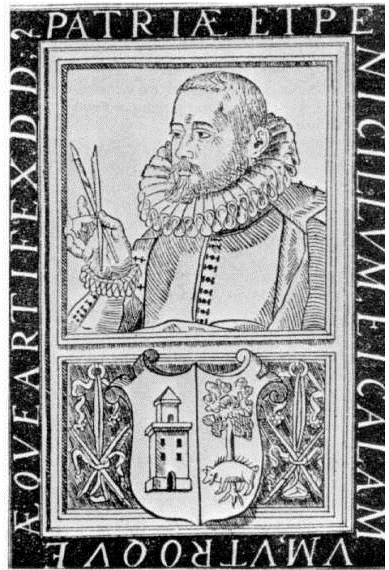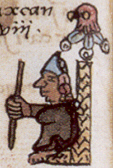|
Codex Escalada
Codex Escalada (or Codex 1548) is a sheet of parchment signed with a date of "1548", on which there have been drawn, in ink and in the European style, images (with supporting Nahuatl text) depicting the Marian apparition of Our Lady of Guadalupe to Juan Diego which allegedly occurred on four separate occasions in December 1531 on the hill of Tepeyac north of central Mexico City. If authentic, and if correctly dated to the mid-16th century (as tests so far conducted indicate), the document fills a gap in the documentary record as to the antiquity of the tradition regarding those apparitions and of the image of the Virgin associated with the fourth apparition which is venerated at the Basilica of Guadalupe. The parchment first came to light in 1995, and in 2002 was named in honour of Fr. Xavier Escalada S.J. who brought it to public attention and who published it in 1997. Description The document is not a codex as the term is generally understood, but a single sheet of parchment ( ... [...More Info...] [...Related Items...] OR: [Wikipedia] [Google] [Baidu] |
Miguel Sánchez (priest)
Miguel Sánchez (1594–1674) was a Novohispanic priest, writer and theologian. He is most renowned as the author of the 1648 publication ''Imagen de la Virgen María'', a description and theological interpretation of an apparition to Juan Diego of the Virgin Mary as Our Lady of Guadalupe which is the first published narrative of the event. The precise nature of the cult before that date and whether the tradition as to the apparition dates back to 1531 (as Sánchez claims), constitute a vexed historical problem. The existence of a cult of the Virgin Mary at a chapel (or ermita) at Tepeyac, focussed on a painted cult image of the Virgin and enjoying a reputation for miraculous healing, was certainly established by 1556. Professor Brading, a scholar of Mexican history, noted of Sánchez: "even if he did not initiate the devotion, he determined the manner in which the image was exalted and justified." Sánchez was born in New Spain (today's Mexico) and studied at the Royal and Ponti ... [...More Info...] [...Related Items...] OR: [Wikipedia] [Google] [Baidu] |
Canonization
Canonization is the declaration of a deceased person as an officially recognized saint, specifically, the official act of a Christian communion declaring a person worthy of public veneration and entering their name in the canon catalogue of saints, or authorized list of that communion's recognized saints. Catholic Church Canonization is a papal declaration that the Catholic faithful may venerate a particular deceased member of the church. Popes began making such decrees in the tenth century. Up to that point, the local bishops governed the veneration of holy men and women within their own dioceses; and there may have been, for any particular saint, no formal decree at all. In subsequent centuries, the procedures became increasingly regularized and the Popes began restricting to themselves the right to declare someone a Catholic saint. In contemporary usage, the term is understood to refer to the act by which any Christian church declares that a person who has died is a sa ... [...More Info...] [...Related Items...] OR: [Wikipedia] [Google] [Baidu] |
Beatification
Beatification (from Latin ''beatus'', "blessed" and ''facere'', "to make”) is a recognition accorded by the Catholic Church of a deceased person's entrance into Heaven and capacity to intercede on behalf of individuals who pray in their name. ''Beati'' is the plural form, referring to those who have undergone the process of beatification; they possess the title of "Blessed" (abbreviation "Bl.") before their names and are often referred to in English as "a Blessed" or, plurally, "Blesseds". History Local bishops had the power of beatifying until 1634, when Pope Urban VIII, in the apostolic constitution ''Cœlestis Jerusalem'' of 6 July, reserved the power of beatifying to the Holy See. Since the reforms of 1983, as a rule, one miracle must be confirmed to have taken place through the intercession of the person to be beatified. Miracles are almost always unexplainable medical healings, and are scientifically investigated by commissions comprising physicians and theologian ... [...More Info...] [...Related Items...] OR: [Wikipedia] [Google] [Baidu] |
Jesuit
, image = Ihs-logo.svg , image_size = 175px , caption = ChristogramOfficial seal of the Jesuits , abbreviation = SJ , nickname = Jesuits , formation = , founders = , founding_location = , type = Order of clerics regular of pontifical right (for men) , headquarters = Generalate:Borgo S. Spirito 4, 00195 Roma-Prati, Italy , coords = , region_served = Worldwide , num_members = 14,839 members (includes 10,721 priests) as of 2020 , leader_title = Motto , leader_name = la, Ad Majorem Dei GloriamEnglish: ''For the Greater Glory of God'' , leader_title2 = Superior General , leader_name2 = Fr. Arturo Sosa, SJ , leader_title3 = Patron saints , leader_name3 = , leader_title4 = Ministry , leader_name4 = Missionary, educational, literary works , main_organ = La Civiltà Cattoli ... [...More Info...] [...Related Items...] OR: [Wikipedia] [Google] [Baidu] |
Baltasar De Echave Orio
Baltasar de Echave Orio (late 16th century – mid-17th century) was a Basque Spanish painter. As there was a painter of the same name, thought to be his son, he is known as Echave the Elder. Life He was born at Zumaya, Guipuzcoa, Spain, and became one of the earliest Spanish artists to reach Mexico, arriving at about the same time, near the end of the 16th century, as Sebastian Arteaga and Alonzo Vasquez. As was tradition for young men of that time, his wife, also a painter, was his instructor. He died in Mexico. His son was Baltasar de Echave Ibía and his grandson was Baltasar de Echave Rioja, both painters.Jonathan Brown, "From Spanish to New Spanish Painting, 1550-1700" in ''Painting in Latin America, 1550-1820'', Luisa Elena Alcalá and Jonathan Brown, eds. New Haven: Yale University Press 2014, p. 133. Works Echave, whose subjects are chiefly religious, had especial skill in composition, and his best works are compared to Guercino. The Academy of San Carlos, Mex ... [...More Info...] [...Related Items...] OR: [Wikipedia] [Google] [Baidu] |
Luis Becerra Tanco
Luis is a given name. It is the Spanish form of the originally Germanic name or . Other Iberian Romance languages have comparable forms: (with an accent mark on the i) in Portuguese and Galician, in Aragonese and Catalan, while is archaic in Portugal, but common in Brazil. Origins The Germanic name (and its variants) is usually said to be composed of the words for "fame" () and "warrior" () and hence may be translated to ''famous warrior'' or "famous in battle". According to Dutch onomatologists however, it is more likely that the first stem was , meaning fame, which would give the meaning 'warrior for the gods' (or: 'warrior who captured stability') for the full name.J. van der Schaar, ''Woordenboek van voornamen'' (Prisma Voornamenboek), 4e druk 1990; see also thLodewijs in the Dutch given names database Modern forms of the name are the German name Ludwig and the Dutch form Lodewijk. and the other Iberian forms more closely resemble the French name Louis, a deriv ... [...More Info...] [...Related Items...] OR: [Wikipedia] [Google] [Baidu] |
Antonio Castro
Operation Countryman was an investigation into police corruption in London in the late 1970s. The operation was conducted between 1978–1982 at a total cost of £3 million and led to eight police officers being prosecuted, although none were convicted. The initial allegations of corruption were made by a supergrass who claimed that some officers, including members of the elite Flying Squad which dealt with commercial armed robberies, were receiving bribes from criminals in return for warnings of imminent police raids or arrests, the fabrication of evidence against innocent men, and having charges against guilty criminals dropped. The investigation initially targeted officers within the City of London Police but spread to include the Metropolitan Police based at Scotland Yard. Codenamed Operation Countryman because of its use of officers from so-called 'rural' police forces of Hampshire and Dorset, the investigating team came to be disparagingly known by London officers as "Th ... [...More Info...] [...Related Items...] OR: [Wikipedia] [Google] [Baidu] |
British Museum
The British Museum is a public museum dedicated to human history, art and culture located in the Bloomsbury area of London. Its permanent collection of eight million works is among the largest and most comprehensive in existence. It documents the story of human culture from its beginnings to the present.Among the national museums in London, sculpture and decorative and applied art are in the Victoria and Albert Museum; the British Museum houses earlier art, non-Western art, prints and drawings. The National Gallery holds the national collection of Western European art to about 1900, while art of the 20th century on is at Tate Modern. Tate Britain holds British Art from 1500 onwards. Books, manuscripts and many works on paper are in the British Library. There are significant overlaps between the coverage of the various collections. The British Museum was the first public national museum to cover all fields of knowledge. The museum was established in 1753, largely b ... [...More Info...] [...Related Items...] OR: [Wikipedia] [Google] [Baidu] |
Aubin Codex
The Aubin Codex is an 81-leaf Aztec codex written in alphabetic Nahuatl on paper from Europe. Its textual and pictorial contents represent the history of the Aztec peoples who fled Aztlán, lived during the Spanish conquest of the Aztec Empire, and into the early Spanish colonial period, ending in 1608. History The first date written in the manuscript is 1576, on the frontispiece. The latest date written is 1607. It appears that various Nahuatl-speaking authors worked on it over that time. It is not known where the codex was during most of the 17th century, or indeed until Italian historian and ethnographer of the New World, Lorenzo Boturini Benaduci, added it to his collection in the mid-18th century. His collection was impounded by Spanish authorities after he was arrested in 1744 for entering New Spain without license. In the early 19th century, the codex was acquired from whereabouts unknown by , a French Americanist and collector, whose name the codex now bears. Som ... [...More Info...] [...Related Items...] OR: [Wikipedia] [Google] [Baidu] |
Antonio Valeriano
Antonio Valeriano (c. 1521–1605) was a colonial Mexican, Nahua scholar and politician. He was a collaborator with fray Bernardino de Sahagún in the creation of the twelve-volume ''General History of the Things of New Spain'', the Florentine Codex, He served as judge-governor of both his home, Azcapotzalco, and of Tenochtitlan, in Spanish colonial New Spain. Career Antonio de Valeriano was the most accomplished pupil and then native scholar at the Franciscan Colegio de Santa Cruz de Tlatelolco. As with other students at the colegio, Valeriano was taught literacy in Nahuatl, Spanish, and Latin. Bernardino de Sahagún singled out Valeriano as "one of my collaborators ... collegians expert in grammar. The principal and most learned of them was Antonio de Valeriano of Atzcapoltzalco." He was also praised by Franciscan Fray Juan Bautista, who preserved the last letter that Valeriano wrote him in Latin. Valeriano says that "my hands are trembling, my eyes are clouded, and my ears ... [...More Info...] [...Related Items...] OR: [Wikipedia] [Google] [Baidu] |






